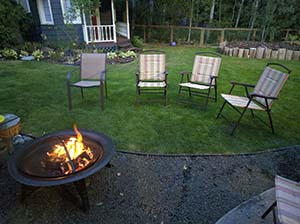
Fire pits are today’s newest trend.
By far, fall is the best time to upgrade your landscape and outdoor space. With cooler temperatures, trees and shrubs are entering dormancy; newly installed plants will require less protection from the hot sun; and watering requirements will be less. Just remember that if you add trees and shrubs to your landscape, you’ll still need to water until they are established.
Take a look at your lawn and landscape and use the next several months to set a path to success for next spring. Find spaces that can benefit from bringing in a group of holly plants, several distinctive evergreens, a few showy maple trees and an eye-catching mass planting of spring- or summer-flowering shrubs.
Make your plans for these projects and space them out to take advantage of sunny warmer winter days:
- Yard and clean-up – remove spent plant materials from raised beds and trim dead limbs from trees and shrubs. However, do not prune spring-flowering azaleas, forsythia or others that bloom on old growth or you’ll be removing next spring’s blossoms.
- Leaf collection – blow leaves from garden spaces that have accumulated under plants and on your turf. Collect them in an out-of-the-way space near your vegetable garden to use as spring mulch or to add to compost. Shred them with your mulching lawn mower or use a leaf shredder to hasten the process. It’s an inexpensive way add organic matter next spring.
- Add perennials – coming back year after year, many perennials attract pollinators and backyard wildlife, providing food all year long. Choose cone flowers, black-eyed Susans, bee balm that self-seeds, asters and others that add color and will reward you with spring and summer blooms.
- Pamper your garden tools – when did you last clean and sharpen lawn mower blade, pruners and clippers? Clean them with a wire brush to remove dried-on dirt and grime, sharpen and oil them with a drop of two of oil, even vegetable, olive or canola oil will work, rather than WD 40 which can gum up tools and is not a good anti-corrosion coating.
- Clean and inspect – your patio and deck furniture. A half-cup of white vinegar and one-fourth a cup of baking soda makes a gentle cleaner to remove dust, dirt and most mildew using a soft brush or sponge. Murphy’s Oil Soap is a good alternative. A toothbrush can get into smaller areas. Protect metal furniture after it’s cleaned by applying car wax. If necessary, replace worn and shabby-looking pieces, ordering over the winter when demand is low and prices can be more affordable.
- Add a firepit – today’s newest trend, the Solo Stove, provides a safe, cozy and smokeless way to enjoy the outdoors from the cool nights of fall and spring to the colder nights of winter. Depending on the size, it can be portable; plus it uses standard firewood.
- Upgrade your grill – Using charcoal, ceramic Kamado Joe Red Eggs can smoke a brisket or pork butt, cook steaks, pizza and burgers or roast vegetables. You can even cook the Thanksgiving bird on one. Some people are adding Traeger pellet grills to their repertoire of outdoor cooking choices to provide slow-cooked wood-fired flavor.
- Build an outdoor kitchen – when the leaves are off the trees, pick a clear site for outdoor entertaining. From installing a stone patio to building a stacked-stone fireplace or a fully equipped outdoor kitchen with specialty appliances, running water and storage, you’re only limited by your imagination and your budget.
- Create activity zones – from a place for cornhole or bocce ball to badminton or a giant checkers board game, provide an alternative to screen time with some family fun. Add a square game table to a patio grouping for an evening of board games or cards.
Just because it’s cold outside, you don’t need to stay inside. Even if you only try one or two of these suggestions, you’ll have a good head start on spring and more ways to enjoy your outdoor space next summer.
Photo: courtesy Pixabay





